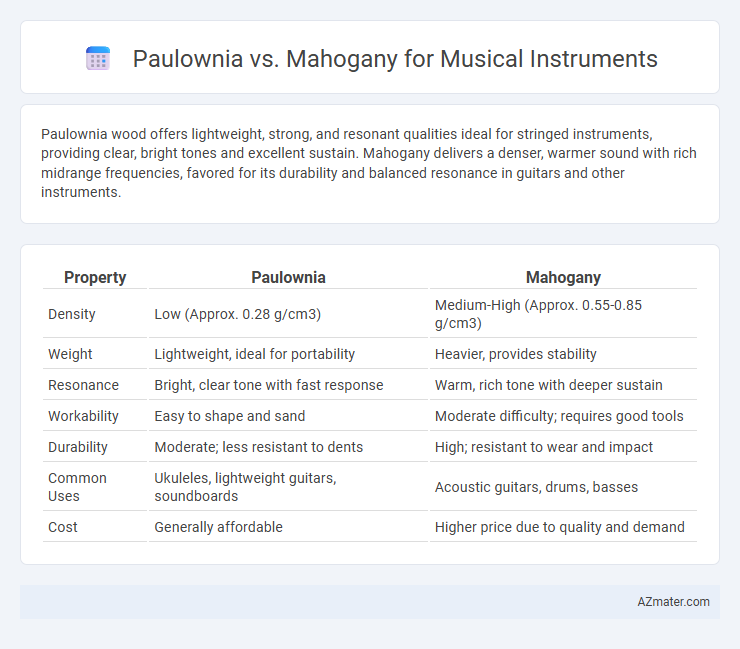Paulownia wood offers lightweight, strong, and resonant qualities ideal for stringed instruments, providing clear, bright tones and excellent sustain. Mahogany delivers a denser, warmer sound with rich midrange frequencies, favored for its durability and balanced resonance in guitars and other instruments.
Table of Comparison
| Property | Paulownia | Mahogany |
|---|---|---|
| Density | Low (Approx. 0.28 g/cm3) | Medium-High (Approx. 0.55-0.85 g/cm3) |
| Weight | Lightweight, ideal for portability | Heavier, provides stability |
| Resonance | Bright, clear tone with fast response | Warm, rich tone with deeper sustain |
| Workability | Easy to shape and sand | Moderate difficulty; requires good tools |
| Durability | Moderate; less resistant to dents | High; resistant to wear and impact |
| Common Uses | Ukuleles, lightweight guitars, soundboards | Acoustic guitars, drums, basses |
| Cost | Generally affordable | Higher price due to quality and demand |
Introduction: Paulownia vs Mahogany in Musical Instruments
Paulownia and mahogany are two popular tonewoods used in musical instrument construction, each offering distinctive acoustic qualities. Paulownia is prized for its light weight and resonant, bright sound, making it ideal for instruments requiring rapid responsiveness and clarity. Mahogany provides a warmer, richer tone with strong midrange presence, favored for its durability and balanced sound in guitars, ukuleles, and other string instruments.
Wood Characteristics: Paulownia and Mahogany Compared
Paulownia wood is lightweight with a soft, straight grain, offering excellent resonance and a bright tone favored for acoustic instruments, while mahogany is denser with a closed grain, providing warmth, sustain, and a rich, balanced sound ideal for electric guitars and ukuleles. Paulownia's low weight enhances playability and reduces fatigue, whereas mahogany's durability ensures long-lasting structural integrity. The contrasting tonal qualities and physical properties make Paulownia suitable for instruments requiring crisp clarity and mahogany preferred for a fuller, mellower sound.
Sound Quality: Tonal Properties of Both Woods
Paulownia wood offers a bright, warm tone with excellent resonance and sustain, making it ideal for instruments requiring clarity and projection such as ukuleles and guitars. Mahogany provides a rich, balanced sound with strong midrange frequencies and a smooth, woody warmth favored in acoustic guitars and basses. The tonal properties of Paulownia emphasize lightness and vibrancy, while Mahogany delivers depth and richness, influencing the choice based on desired sound quality.
Weight and Workability: Luthier Preferences
Paulownia wood is significantly lighter than mahogany, making it ideal for luthiers prioritizing reduced instrument weight without sacrificing tonal quality. Its soft texture ensures superior workability, allowing for precise carving and shaping compared to the denser, harder mahogany, which requires more effort but offers a classic warm resonance. Many luthiers favor paulownia for innovative designs needing ease of handling, while mahogany remains preferred for traditional builds valuing robustness and sustain.
Durability and Longevity in Instruments
Paulownia wood offers lightweight properties and moderate durability, making it suitable for instruments where ease of handling and resonance are prioritized; however, it is less dense and generally less resistant to impact compared to mahogany. Mahogany provides superior durability and longevity due to its dense grain structure and resistance to warping, contributing to the stability and extended lifespan of guitars and other stringed instruments. Instruments crafted from mahogany tend to maintain tonal quality over time, making mahogany a preferred choice for durability in professional-grade musical instruments.
Cost and Availability for Instrument Makers
Paulownia offers a cost-effective and readily available option for musical instrument makers, especially in markets with growing sustainable wood demand. Mahogany, while more expensive and sometimes limited due to stricter logging regulations, provides a dense, resonant tone highly valued in premium instruments. Instrument makers weighing cost and availability often prefer Paulownia for budget-friendly projects and Mahogany for high-end craftsmanship and durability.
Sustainability: Environmental Impact of Harvesting
Paulownia is a highly sustainable choice for musical instruments due to its rapid growth rate and ability to regenerate quickly after harvesting, minimizing deforestation impact. In contrast, mahogany is slower-growing and often harvested from endangered tropical forests, raising significant environmental concerns. Choosing Paulownia supports eco-friendly practices by reducing habitat destruction and carbon footprint associated with timber extraction.
Applications: Common Uses in Guitars, Ukuleles, and More
Paulownia wood is favored in guitar and ukulele construction for its lightweight properties and excellent resonance, making it ideal for travel instruments and acoustic projects where portability and brightness are desired. Mahogany, known for its rich, warm tonal qualities and durability, is commonly used in high-end guitars and ukuleles to enhance sustain and provide a balanced sound across frequencies. Both woods serve distinct applications: Paulownia excels in crafting lightweight, responsive bodies, while Mahogany is preferred for instruments requiring depth and tonal warmth.
Player Feedback: Musicians’ Experiences and Preferences
Musicians often prefer Paulownia for its lightweight feel and bright, resonant tone, making it ideal for portable instruments like ukuleles and travel guitars. Mahogany receives praise for its warm, rich sound and strong midrange, favored in acoustic guitars for deeper tonal complexity and sustain. Player feedback highlights Paulownia's responsiveness and ease of play, while Mahogany is valued for its durability and classic sound signature, influencing choice based on style and performance needs.
Conclusion: Choosing the Right Wood for Your Instrument
Paulownia wood offers lightweight properties and excellent resonance, making it ideal for instruments requiring quick response and vibrant tones, while mahogany provides durability and warm, rich sound qualities favored in guitars and percussion. Selecting paulownia enhances playability and portability, whereas mahogany ensures long-lasting structural integrity and a deep, mellow sound profile. The decision depends on the desired tonal character and instrument use, with paulownia suited for bright, agile sounds and mahogany preferred for robust, warm acoustics.

Infographic: Paulownia vs Mahogany for Musical Instrument
 azmater.com
azmater.com